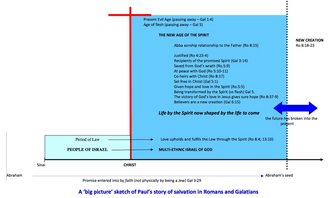 In a remarkable piece of insight, Tom Wright once asked what Pauline theology would look like if we began with Ephesians and Colossians instead of Romans, and in just a few pages (168-175) in Justification: God’s Plan & Paul’s Vision
In a remarkable piece of insight, Tom Wright once asked what Pauline theology would look like if we began with Ephesians and Colossians instead of Romans, and in just a few pages (168-175) in Justification: God’s Plan & Paul’s Vision, he discusses the vision of Ephesians. (By the way, it could make a huge difference.)
Notice these words: “And of course it is in Ephesians that the two ‘halves’ of the Pauline gospel emphasis are laid out side by side. Ephesians 2:1-10 is the old perspective: sinners saved by grace through faith. Ephesians 2:11-22 is the new perspective: Jews and Gentiles coming together in Christ.” And, he continues: “they belong intimately together” (168).
Here is the temptation: the old perspective can downplay the second as central; the new perspective can downplay the first as central. Is this the central theological difference: seeing Paul through the personal salvation mode or seeing Paul through the union of Jews and Gentiles mode?
This incipient (universal) ecclesiology, Wright observes, merely “a pleasing decoration, a side-comment on what a fine thing the gospel is” (168). This whole Jew-Gentile thing “is part of the reality of the gospel” (169).
Ecclesiology, so devalued into a voluntary society for low church evangelicals, is at the heart of the Pauline gospel.
From Eph 2:9-10 Wright distinguishes salvation from justification: “justification is God’s declaration that someone is in the right, a member of the sin-forgiven covenant family, while salvation is the actual rescue from death and sin” (170).
And saved not by works but for works, the standard Protestant approach, is not far from what the new perspective actually teaches (here, here). Wright thinks the point of “good works” is an ecclesial face of the presence of God’s redemptive work in the Messiah (171). So, he wants “good works” to be a little more robust, and not just individuals doing virtuous things.
And the destruction of the dividing wall, if anywhere, shows that Torah is understood very close the boundary markers that Jimmy Dunn has so emphasized: Christ destroyed what separated Jews from Gentiles. We are staring here then at Galatians 3:28-29: we are one in Christ — and that is what the gospel does! This is the mystery of the gospel (Eph 3:1-7). This union is the sign to the principalities and powers that the time is up (173).
He brings it back: low ecclesiology works against these texts in promoting too radical of an individualism.
Maybe more of us need to teach Paul’s theology through the lens of Ephesians. Any takers?

